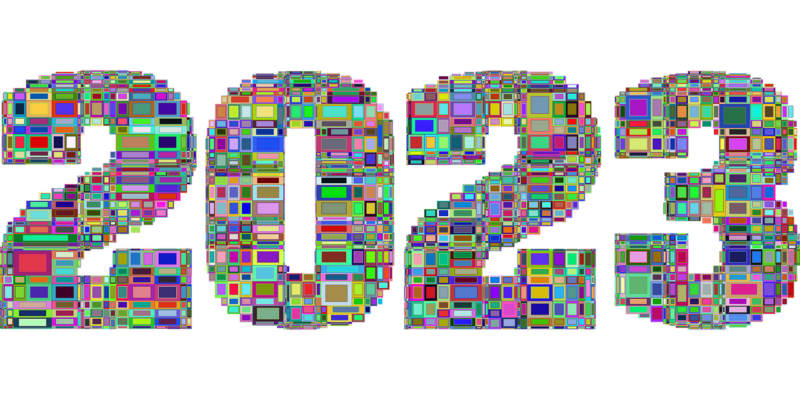
Now that the midterms are behind us, it’s time to roll up our sleeves and get back to work. With the holiday season upon us at Deksia/Anvil, it’s time to pour a glass of pumpkin spice eggnog, put on our foil-covered “thinking” caps and gaze into the crystal ball to devine annual predictions. Our tradition is almost as old as Mark Zuckerberg, but not as scary. Each year, our annual practice of sharing marketing trends for the next 12 months is never easy, but we try to keep it fun and a little outrageous. We also aren’t afraid to reflect and evaluate the accuracy of the previous year’s predictions. If you want to read “no doy” level marketing predictions, check elsewhere. Without further adieu, here are Deksia’s 2023 marketing predictions for your enjoyment.
Localized Marketing will go Global and Globalized Marketing will go Local
As evolving tools and technologies lower the barriers to remote work in a post-COVID world, businesses will no longer be constrained by geographic barriers, both in terms of recruiting talent and adding new customers. Marketers who understand that the New Normal is a decentralized, global village will have an advantage. That includes both localized targeting for messages to resonate at a community level, as well as global outreach based on interest, expertise, and need. This trend will bode well for Account Based Marketing (ABM) and Account Based Sales (ABS) strategies, where a named account approach drives targeting and messaging by business-to-business (B2B) organizations.
Zoomers will Replace Boomers
Generation Y (Millennials) is maturing, raising families, and buying homes. Meanwhile, Generation Z (Zoomers) is a growing audience for brands. The purchasing behavior for both is remarkably different than any prior generation, especially for Generation Z. In business, as Boomers retire, Millennials are rising in the ranks and are moving from influencers to decision-makers. Messaging will need to be revised to resonate with younger audiences that value aligned purposes, including sustainability, transparency, diversity, and inclusion. Additionally, brands that help simplify the overwhelming choices younger generations have when making decisions, will convert more new customers. In 2023, we expect to see a massive shift in targeting, market messaging, and channel mix.
Google Search Will Expand its Capabilities to Support Online Shopping
Over the past two years, Google has significantly improved its ability to support the needs of online shoppers. Google’s Shopping Graph was the first major update that centralized all of the components of a well-balanced shopping experience such as reviews, pricing, and sellers. As a result of the pandemic, Google also made it entirely free for businesses to sell products on their platform by eliminating their commission fees. Now, the latest update to Google search includes a buying guide that offers additional product details within a drop-down menu, giving users all of the information they’re looking for in one simple step. All of these advancements, combined with the horsepower of Google MUM, validates our expectation that Google will continue its online shopping evolution.
SEO will Expand to Social Media Platforms
As mentioned above, younger generations are becoming the new target audiences for brands. According to the New York Times, Gen Z is not adhering to the traditional method of using Google for research. In fact, about 40% of those who belong to the younger generations will go to TikTok or Instagram to conduct their research. Whether the search is for a new restaurant or a how-to video, Gen Z is leveraging social media platforms to find what they need. Social media algorithms are not only incredibly successful in providing tailored feeds to their users, but real people are providing the information. In order to connect with younger generations, traditional SEO is going to expand outside of standard search engines and into popular social platforms.
Google Ads will become more about Asset Management and less about Detailed Optimizations
Years ago, Google Ads users’ day-to-day work was surrounded by making minor changes to bids, keywords, and a number of other factors to outperform competitors. As time has gone on, Google has taken these tasks off of marketers’ plates and introduced things like smart bidding and performance max campaigns. This has shifted the focus of Google Ads professionals from these minor optimizations to fueling Google’s learning algorithms with information. Moving into 2023, we predict these features will be more critical than ever as Google moves to further promote its new Performance Max campaigns, broad match keywords, and new features to manage assets Google has to work with. This includes a better recording of conversion data, managing product feeds, and adjusting ad assets such as images and text. Google Ads professionals that can make this shift will be able to make the most of Google’s machine learning and optimization opportunities.
TikTok Will Emerge as a Prevalent Music Streaming Platform
In a recent article from TechCrunch, it was revealed that TikTok’s parent company ByteDance is anticipating the release of a music streaming/sharing service. In recent years, TikTok has proven to be one of the most highly-downloaded social media applications and has increasingly closed the gap between itself and other powerhouse platforms like Facebook Messenger and Instagram, in terms of monthly average users. In fact, Millennials and Zoomers are particularly active on the platform. They’re using it to discover new ideas, share entertainment, short-form education, funky dance moves, and more. Trending memes, challenges, and audio clips are already commonplace in the lexicon of the platform. It is within the realm of possibility that this music service, leveraged alongside TikTok’s already-growing popularity, will be used to create everyone’s New Year’s playlists for 2024!
BeReal will Become Real for Marketers
An article from the Business of Apps identifies that BeReal is one of the fastest-growing social media apps today. Data analysis showed that with a staggering 7.67 million users, the app has increased by over 315% since the start of 2022. BeReal focuses on genuine, raw, and unedited content that users crave while using other highly-edited social media platforms. It even gives businesses the opportunity to showcase an authentic side of their company using this platform. Although BeReal does not offer advertising options at this time, companies like Chipotle have embraced the app by offering a free meal to the first 100 customers who used the coupon code posted on their BeReal account (source: Influencer Marketing Hub). BeReal also opens an entirely new market for influencers and user-generated content, so brands targeting younger audiences will jump on the opportunity to reach this fickle demographic in 2023. Yes, we know TikTok has nearly identical functionality, but that platform doesn’t encourage people to “be real,” and we feel that is what people are going to want and need in the years to come.
UGC will Evolve from Content to Commerce Channel
User-generated content (UGC) has been around since the advent of dictionaries and early 1990’s Internet user groups. In more recent years, UGC has grown in popularity with the explosive growth of social media usage. 2023 will be the year UGC pivots to mission-critical status with established brands. No longer a marketing gimmick or experiment, UGC will become an essential component of digital (and increasingly analog) content marketing programs. Marketers will formalize programs dedicated to identifying, harvesting, and curating quality content created by customers, employees, fans, and influencers. Beyond social media posts, look for content creators to co-create content for websites, email, traditional print, broadcast, and even product packaging. Nike’s new Swoosh web 3 experience is an early example of what is possible co-creating with fans. With advanced measurement, Web 3, and AI, brands will be more easily able to organize and measure the impact of UGC content, with the ideal outcome being a compensation program. Whether leveraging standard affiliate or loyalty programs or exploring a web 3 solution involving crypto or NFTs, content creators will evolve into a critical content marketing source.
Marketing will get Very Personal
It has been stated that efficiency, convenience, knowledgeable and friendly service, and easy payment options are what people value most in their customer experience, and we predict that a more personalized customer-based experience that is tailored to customer needs will become even more important. In 2023, platforms will automatically generate ads and highly curated content for each individual user, giving everyone a unique browsing experience. Google ads will be replaced by AI’s machine learning, transforming the concept of behavioristics and how people search by replacing active human involvement with their AI companion equivalent, directly feeding users the content that the AI brain created.
AR/VR Will Evolve into a Standardized Component of Remote Meetings
With the introduction of Meta Quest Pro, we expect a significant increase in conference calls utilizing virtual reality (VR) and augmented reality (AR). VR will allow attendees to interact as if everyone is in the same physical space, and using VR headsets will provide an opportunity to collaborate in the virtual realm without the cost and inconvenience of travel. Using VR will help you feel as if you are established in the environment; it allows for the ability to move and interact with people that you couldn’t with a web or phone conference call. For example, new VR meetings can have realistic faces of attendees and where you sit affects what you can hear or see, while the additional functionality of having a virtual computer at your fingertips provides additional interactivity and functionality that is not available in a traditional conference room.
AI Will Become One with Us
2023 will prove to be a breakout year for artificial intelligence (AI), for marketers and consumers alike. We’ve all seen what AI can do to improve searches on Google in the past few years, but the technology is now providing compelling learning, collaboration, and marketing experiences. For example, as consumers use the Google Lens app and phone camera to understand objects in their environment, Google’s technology will automatically create customer ads relating to the object and offer in-app purchase options for advertisers. AI is also beginning to show significant promise in areas we once designated as being uniquely human. For instance, AI-powered art has won awards, and AI writing tools like Jasper AI are regularly providing significant assistance to copywriters in both content creation and editing. Even if you’re not employing a designated tool, you can already see this technology moving into mainstream platforms like Gmail via writing suggestions. As organizations like OpenAI and others continue to invest in this space, we’re likely to see adoption increase substantially in 2023.
So there you have it… 11 predictions from across the marketing ecosystem that we believe will impact your business and customers in 2023. For more updates on digital marketing trends, visit our blog. Feel free to share your thoughts in the comments section below, both about our predictions as well as yours! Market safely!

Kent Lewis founder of pdxMindShare, an online career community and networking group mentioned on Seth Godin’s blog. Formerly a CMO and founder or co-founder of multiple agencies, he’s known as a thought leader in digital marketing. He’s been an adjunct professor for more than 20 years at Portland State University and a volunteer instructor for SCORE. Lewis co-founded SEMpdx in 2006, a trade organization for search engine marketing professionals. His recognition includes Marketer of the Year by the American Marketing Association and Top 100 Digital Marketing Influencers by BuzzSumo.
